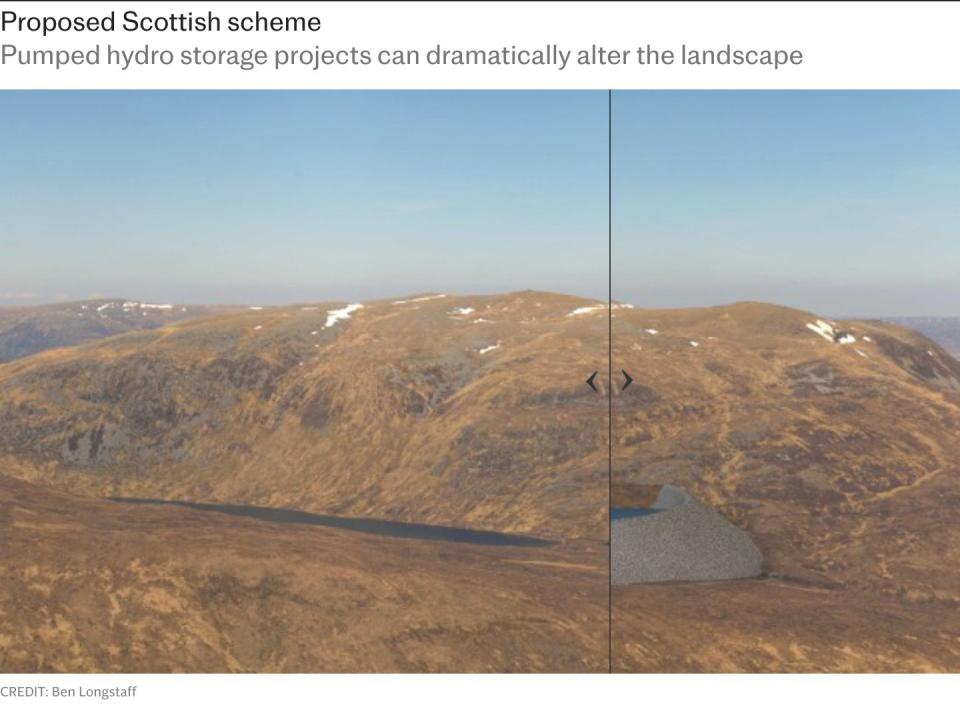Ed Miliband unlocks billions to build giant dams across Britain

A string of giant dams are to be built across Britain’s mountain landscapes after Ed Miliband offered developers billions of pounds in potential support for the projects.
In a bid to strengthen the country’s energy storage capabilities, the Energy Secretary has approved a scheme that will provide a financial safety net for dam developers.
The proposal has been approved to encourage a spate of new dam projects across England and Scotland, which will be used to store backup hydropower for times when wind and solar farms cannot meet electricity demand.
The eventual cost of supporting such projects will be added to consumer bills, with Mr Miliband introducing the backstop to help developers make a profit.
The technology behind the dams relies on pumped storage hydropower (PSH), which uses two reservoirs at different elevations.
Water is pumped into the upper lake when there is surplus cheap power and then released during shortages to spin turbines and generate electricity.
Such systems are highly controversial because while they can provide green energy, they also require altering entire landscapes, often in treasured rural or wild areas.

Energy Minister Michael Shanks said: “We need to increase our ability to store energy for when the sun isn’t shining, or the wind isn’t blowing.
“With these projects storing the surplus clean, homegrown energy produced from renewable sources, we can boost our energy security by relying less on fossil fuels, protect household bills, and help make Britain a clean energy superpower.”
The UK already has four pumped hydropower schemes – two in Scotland and two in Wales. The largest is at Dinorwig in Wales, opened in 1984 in Snowdonia National Park.
The power station was built inside Elidir Fawr mountain using a reservoir built 2,000 feet above sea level and linked to a second lake 1,700 feet lower down.
Mr Miliband and Mr Shanks want to unleash many other schemes over the next two decades, meaning many new dams will be built across mountainous regions in Britain.
Under the so-called cap and floor funding scheme, developers will have a guaranteed minimum income in return for a limit on revenues.
A spokesman for the Department of Energy Security and Net Zero said deploying 20 gigawatts of long-term energy storage – an eight-fold expansion – could save the electricity system £24bn by 2050.
This, they claimed, would “reduce household energy bills as additional cheaper renewable energy would be available to meet demand at peak times”.
Several hydro projects, targeting up to a dozen lochs, are already at the planning stage in Scotland.

A number of schemes are centred around Loch Ness, where critics say the projects will damage the local environment.
Brian Shaw, river director of the Ness District Salmon Fishery Board, said: “In places such as Loch Ness, this scale of pump storage hydro will overrun natural ecological processes, destroy the loch and surrounding ecosystems’ biodiversity, and devalue one of Scotland’s premier tourism destinations, all in the quest for not-so-cheap electricity.”
One of the largest is Earba, near Dalwhinnie, on the Ardverikie Estate, whose stately home was used for filming TV series including The Crown and Monarch of the Glen.
Davie Black, of Mountaineering Scotland, which represents climbers and hikers, said such projects were “incursions into the wild qualities of our hill country”.
He said: “These are the only ‘wild’ places left where people can escape the pressures of modern urban living. We risk demeaning one of Scotland’s, and Britain’s, most precious and fragile assets – its open wild landscapes.”
However, Mr Miliband has made clear that low-carbon energy generation will almost always take precedence over landscape protection, having already approved a number of giant solar farms and pylon schemes across prime English farmland.
Kate Gilmartin, chief executive of the British Hydropower Association, the industry trade body, said dams and lakes were among the least intrusive of renewable energy technologies.
She said: “The biggest winners are energy consumers. We are currently paying about £62m a day to curtail wind as we haven’t got sufficient capacity across the grid to move it from Scotland to England.
“The more we can store for release when the wind drops, the less those costs will be, also helping avoid using the very expensive peaking gas plants that back up wind and solar.”